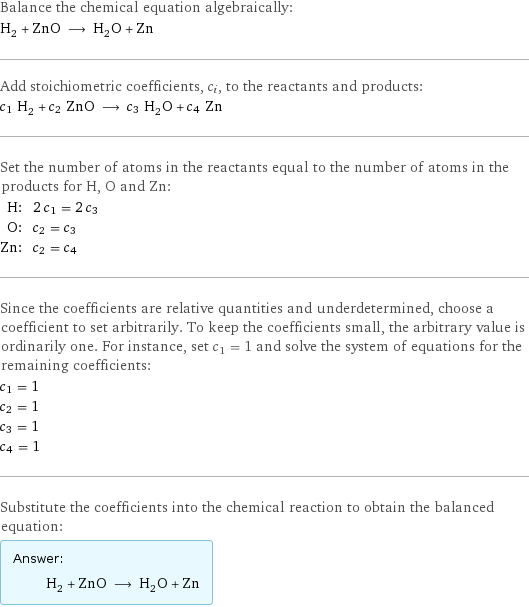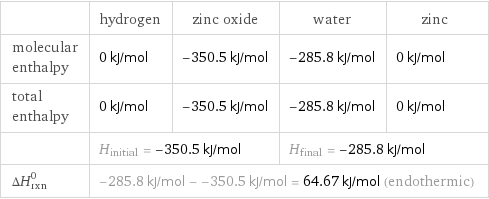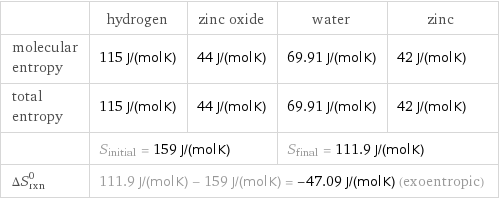Input interpretation

H_2 (hydrogen) + ZnO (zinc oxide) ⟶ H_2O (water) + Zn (zinc)
Balanced equation

Balance the chemical equation algebraically: H_2 + ZnO ⟶ H_2O + Zn Add stoichiometric coefficients, c_i, to the reactants and products: c_1 H_2 + c_2 ZnO ⟶ c_3 H_2O + c_4 Zn Set the number of atoms in the reactants equal to the number of atoms in the products for H, O and Zn: H: | 2 c_1 = 2 c_3 O: | c_2 = c_3 Zn: | c_2 = c_4 Since the coefficients are relative quantities and underdetermined, choose a coefficient to set arbitrarily. To keep the coefficients small, the arbitrary value is ordinarily one. For instance, set c_1 = 1 and solve the system of equations for the remaining coefficients: c_1 = 1 c_2 = 1 c_3 = 1 c_4 = 1 Substitute the coefficients into the chemical reaction to obtain the balanced equation: Answer: | | H_2 + ZnO ⟶ H_2O + Zn
Structures

+ ⟶ +
Names

hydrogen + zinc oxide ⟶ water + zinc
Reaction thermodynamics
Enthalpy

| hydrogen | zinc oxide | water | zinc molecular enthalpy | 0 kJ/mol | -350.5 kJ/mol | -285.8 kJ/mol | 0 kJ/mol total enthalpy | 0 kJ/mol | -350.5 kJ/mol | -285.8 kJ/mol | 0 kJ/mol | H_initial = -350.5 kJ/mol | | H_final = -285.8 kJ/mol | ΔH_rxn^0 | -285.8 kJ/mol - -350.5 kJ/mol = 64.67 kJ/mol (endothermic) | | |
Entropy

| hydrogen | zinc oxide | water | zinc molecular entropy | 115 J/(mol K) | 44 J/(mol K) | 69.91 J/(mol K) | 42 J/(mol K) total entropy | 115 J/(mol K) | 44 J/(mol K) | 69.91 J/(mol K) | 42 J/(mol K) | S_initial = 159 J/(mol K) | | S_final = 111.9 J/(mol K) | ΔS_rxn^0 | 111.9 J/(mol K) - 159 J/(mol K) = -47.09 J/(mol K) (exoentropic) | | |
Equilibrium constant
![Construct the equilibrium constant, K, expression for: H_2 + ZnO ⟶ H_2O + Zn Plan: • Balance the chemical equation. • Determine the stoichiometric numbers. • Assemble the activity expression for each chemical species. • Use the activity expressions to build the equilibrium constant expression. Write the balanced chemical equation: H_2 + ZnO ⟶ H_2O + Zn Assign stoichiometric numbers, ν_i, using the stoichiometric coefficients, c_i, from the balanced chemical equation in the following manner: ν_i = -c_i for reactants and ν_i = c_i for products: chemical species | c_i | ν_i H_2 | 1 | -1 ZnO | 1 | -1 H_2O | 1 | 1 Zn | 1 | 1 Assemble the activity expressions accounting for the state of matter and ν_i: chemical species | c_i | ν_i | activity expression H_2 | 1 | -1 | ([H2])^(-1) ZnO | 1 | -1 | ([ZnO])^(-1) H_2O | 1 | 1 | [H2O] Zn | 1 | 1 | [Zn] The equilibrium constant symbol in the concentration basis is: K_c Mulitply the activity expressions to arrive at the K_c expression: Answer: | | K_c = ([H2])^(-1) ([ZnO])^(-1) [H2O] [Zn] = ([H2O] [Zn])/([H2] [ZnO])](../image_source/cdc707f27f3a9c16c2db548d6096ac75.png)
Construct the equilibrium constant, K, expression for: H_2 + ZnO ⟶ H_2O + Zn Plan: • Balance the chemical equation. • Determine the stoichiometric numbers. • Assemble the activity expression for each chemical species. • Use the activity expressions to build the equilibrium constant expression. Write the balanced chemical equation: H_2 + ZnO ⟶ H_2O + Zn Assign stoichiometric numbers, ν_i, using the stoichiometric coefficients, c_i, from the balanced chemical equation in the following manner: ν_i = -c_i for reactants and ν_i = c_i for products: chemical species | c_i | ν_i H_2 | 1 | -1 ZnO | 1 | -1 H_2O | 1 | 1 Zn | 1 | 1 Assemble the activity expressions accounting for the state of matter and ν_i: chemical species | c_i | ν_i | activity expression H_2 | 1 | -1 | ([H2])^(-1) ZnO | 1 | -1 | ([ZnO])^(-1) H_2O | 1 | 1 | [H2O] Zn | 1 | 1 | [Zn] The equilibrium constant symbol in the concentration basis is: K_c Mulitply the activity expressions to arrive at the K_c expression: Answer: | | K_c = ([H2])^(-1) ([ZnO])^(-1) [H2O] [Zn] = ([H2O] [Zn])/([H2] [ZnO])
Rate of reaction
![Construct the rate of reaction expression for: H_2 + ZnO ⟶ H_2O + Zn Plan: • Balance the chemical equation. • Determine the stoichiometric numbers. • Assemble the rate term for each chemical species. • Write the rate of reaction expression. Write the balanced chemical equation: H_2 + ZnO ⟶ H_2O + Zn Assign stoichiometric numbers, ν_i, using the stoichiometric coefficients, c_i, from the balanced chemical equation in the following manner: ν_i = -c_i for reactants and ν_i = c_i for products: chemical species | c_i | ν_i H_2 | 1 | -1 ZnO | 1 | -1 H_2O | 1 | 1 Zn | 1 | 1 The rate term for each chemical species, B_i, is 1/ν_i(Δ[B_i])/(Δt) where [B_i] is the amount concentration and t is time: chemical species | c_i | ν_i | rate term H_2 | 1 | -1 | -(Δ[H2])/(Δt) ZnO | 1 | -1 | -(Δ[ZnO])/(Δt) H_2O | 1 | 1 | (Δ[H2O])/(Δt) Zn | 1 | 1 | (Δ[Zn])/(Δt) (for infinitesimal rate of change, replace Δ with d) Set the rate terms equal to each other to arrive at the rate expression: Answer: | | rate = -(Δ[H2])/(Δt) = -(Δ[ZnO])/(Δt) = (Δ[H2O])/(Δt) = (Δ[Zn])/(Δt) (assuming constant volume and no accumulation of intermediates or side products)](../image_source/572473a96a93dd25ba632be365f34786.png)
Construct the rate of reaction expression for: H_2 + ZnO ⟶ H_2O + Zn Plan: • Balance the chemical equation. • Determine the stoichiometric numbers. • Assemble the rate term for each chemical species. • Write the rate of reaction expression. Write the balanced chemical equation: H_2 + ZnO ⟶ H_2O + Zn Assign stoichiometric numbers, ν_i, using the stoichiometric coefficients, c_i, from the balanced chemical equation in the following manner: ν_i = -c_i for reactants and ν_i = c_i for products: chemical species | c_i | ν_i H_2 | 1 | -1 ZnO | 1 | -1 H_2O | 1 | 1 Zn | 1 | 1 The rate term for each chemical species, B_i, is 1/ν_i(Δ[B_i])/(Δt) where [B_i] is the amount concentration and t is time: chemical species | c_i | ν_i | rate term H_2 | 1 | -1 | -(Δ[H2])/(Δt) ZnO | 1 | -1 | -(Δ[ZnO])/(Δt) H_2O | 1 | 1 | (Δ[H2O])/(Δt) Zn | 1 | 1 | (Δ[Zn])/(Δt) (for infinitesimal rate of change, replace Δ with d) Set the rate terms equal to each other to arrive at the rate expression: Answer: | | rate = -(Δ[H2])/(Δt) = -(Δ[ZnO])/(Δt) = (Δ[H2O])/(Δt) = (Δ[Zn])/(Δt) (assuming constant volume and no accumulation of intermediates or side products)
Chemical names and formulas

| hydrogen | zinc oxide | water | zinc formula | H_2 | ZnO | H_2O | Zn Hill formula | H_2 | OZn | H_2O | Zn name | hydrogen | zinc oxide | water | zinc IUPAC name | molecular hydrogen | oxozinc | water | zinc